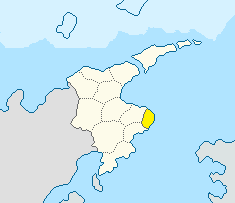Bassovento
| Bassovento Lowwind |
|
|---|---|
| Region of |
|
 |
|
| Capital | Panoli |
| Government | |
| • President | Gianni Alemanno (PNV) |
| Area | |
| • Total | 23,423.04 km2 (9,043.69 sq mi) |
| Population (1747 AN) | |
| • Total | 304,421 |
| • Density | 13/km2 (34/sq mi) |
| Demonym | Bassoventese |
| Time zone | CMT+3 |
Bassovento (/ˈbas͡sovˈɛnto/), in Istvanistani sometimes referred to as Lowwind, is a region of Vegno, located in the extreme east section of the country, bordering the regions of Compare and the Cossa to the west, and overlooks for a lot of km of beaches into the Strait of Pearls. The region comprises a population of about 304,421 people (as 1747 AN).
Its chief town and largest city is Panoli.
Toponymy
The name of the region derives from a typical geographical feature of this region: in fact, in spring and autumn a typical wind usually blows close to the ground and the beaches, especially in the areas in the middle of the hills, in the second part of the day. From this derives the name Bassovento, which in Vegnian means precisely low wind.
Geography
Bassovento extends over an area of 23,423.04 square kilometres (9,043.69 sq mi) of the central slope between Compare and Cossa to the west, with the entire eastern boundary being formed by the Strait of Pearls.
Most of the region is flat or hilly: the Grecale hills run longitudinally along the region's western border and descends through a flat landscape towards the Strait of Pearls. The hilly area covers two-thirds of the region and is intersected by wide gullies with numerous short rivers and by alluvial plains perpendicular to the Grecale.
The coastline is 264 kilometres (164,042 mi) long and is relatively flat and straight except for the hilly area near Buttighia in the north.Inland, in the hilly areas, is more continental with cold and often snowy winters; by the sea is warmer. Precipitation varies from 1,000 to 1,500 millimetres (40 to 60 inches) per year.
Economy
Today the contribution of agriculture to the economy of the region is less significant and the gross value generated by this sector remains slightly above the national average. The main products are cereals, vegetables, animal products and grapes. Truffle hunting is popular; although it has often led to 'truffle wars' between hunters due to the imposition of quotas. Olives are also produced and managed by various harvesters. In spite of the marine impoverishment, the sea has always furnished a plentiful supply of fish, the main fishing centres being Panoli and Buttighia.
Since the 1706, with the independence of Vegno, the economy of the region has been radically transformed without, however, repudiating its rural past. Many of the small craft workshops scattered throughout the rural settlements have modernised and become small businesses, some of which have become major brands. This evolution led to the emergence of 'specialized' industrial areas, which are still profitable:
- footwear and leather goods in a large area straddling the provinces of Buttighia;
- furniture in the Biancavilla area in particular;
- household appliances and textile industry in the province of Panoli, in which the main engineering companies are also to be found (including ship building, petrochemicals and paper, as well as consumer durables).
The region continues to draw tourists, whose increasing numbers have been attracted by the traditional seaside resorts, tipically from the nothern regions of Vegno, but also from other nations of Micras.
Administrative divisions
| Province | Area (km2) | Population
(1747 AN census) |
Density
(inhabitants/km2) |
|---|---|---|---|
| Panoli | 8,961.12 | 143,077 | 15.97 |
| Buttighia | 8,657.28 | 87,277 | 10.08 |
| Biancavilla | 5,804.64 | 74,095 | 12.76 |
